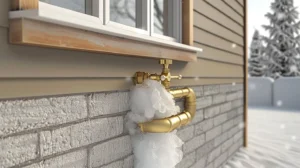We all want our homes to be a safe haven, a place where we can breathe easy and feel comfortable. But did you know that the air inside your home can be more polluted than the air outside? From cooking fumes to pet dander and even the off-gassing from furniture, indoor air quality can suffer if not properly managed. The good news is that improving air quality in your home is easier than you might think, and proper ventilation is the key. Let’s explore how to freshen up your indoor air and create a healthier living environment for you and your family.
Why Ventilation Matters
Proper ventilation is essential for maintaining good indoor air quality. It helps remove stale air, reduces moisture levels, and brings in fresh air from the outside. Without adequate ventilation, pollutants like dust, allergens, and volatile organic compounds (VOCs) can build up, leading to health issues such as allergies, asthma, and other respiratory problems. Ventilation also helps control humidity, preventing the growth of mold and mildew, which can further impact air quality and health.
Maximize Natural Ventilation
One of the simplest and most effective ways to improve indoor air quality is to maximize natural ventilation. Opening windows and doors allows fresh air to circulate through your home, flushing out pollutants and bringing in clean air. Cross-ventilation is particularly effective—open windows on opposite sides of your home to create a breeze that carries stale air out and fresh air in.
To get the most out of natural ventilation, take advantage of cooler times of the day, such as early morning or late evening. This not only brings in fresh air but also helps regulate indoor temperatures during warmer months. If you’re concerned about security or energy loss, consider installing window locks that allow you to keep windows slightly ajar while still securing your home.
Use Exhaust Fans Wisely
Exhaust fans are your best friend when it comes to removing moisture and pollutants from specific areas in your home. Kitchens and bathrooms are two of the most critical areas where exhaust fans should be used regularly. Cooking can release a variety of pollutants into the air, including grease, smoke, and carbon monoxide. Running the kitchen exhaust fan while cooking helps vent these pollutants outside, keeping your indoor air cleaner.
In the bathroom, exhaust fans are crucial for removing moisture from showers and baths. Excess moisture can lead to mold growth, which can negatively affect air quality and trigger allergies or asthma. Make it a habit to run the bathroom fan during and after showers to keep the air dry and fresh.
Invest in a Whole-House Ventilation System
For those looking for a more comprehensive solution, investing in a whole-house ventilation system can make a significant difference in your indoor air quality. These systems work by continuously exchanging stale indoor air with fresh outdoor air. There are several types of whole-house ventilation systems to choose from, including:
- Exhaust Ventilation Systems: These systems use exhaust fans to remove air from your home, allowing fresh air to enter through vents or other openings.
- Supply Ventilation Systems: These systems bring fresh air into your home through an intake vent, while stale air escapes through natural leaks or exhaust vents.
- Balanced Ventilation Systems: As the name suggests, balanced systems use both exhaust and supply fans to create a consistent flow of fresh air in and stale air out, providing the most effective ventilation.
While whole-house ventilation systems require an upfront investment, they are highly effective at maintaining consistent indoor air quality and can be especially beneficial in tightly sealed, energy-efficient homes.
Use Air Purifiers as a Supplement
While proper ventilation is crucial, air purifiers can be a helpful supplement, especially in rooms where ventilation is limited. Air purifiers work by filtering out airborne particles like dust, pollen, pet dander, and even some VOCs. Look for air purifiers with HEPA filters, as they are most effective at trapping small particles.
Place air purifiers in high-traffic areas or rooms where you spend the most time, such as bedrooms or living rooms. Keep in mind that while air purifiers can improve air quality, they should not replace ventilation. Instead, think of them as an additional layer of protection against indoor pollutants.
Control Humidity Levels
Maintaining the right humidity level in your home is key to good air quality. High humidity levels can encourage mold growth and dust mites, while low humidity can dry out your skin, irritate your respiratory system, and worsen allergies. Aim to keep indoor humidity between 30% and 50%.
Using a dehumidifier in damp areas like basements can help reduce excess moisture, while a humidifier can add moisture to the air during dry winter months. Don’t forget to regularly clean and maintain these devices to prevent mold and bacteria growth.
Keep Your Home Clean
A clean home is a healthier home, and regular cleaning plays a vital role in maintaining good indoor air quality. Dust, vacuum, and mop frequently to reduce the amount of dust, pet dander, and other particles that can accumulate in your home. Use a vacuum cleaner with a HEPA filter to trap small particles that can otherwise get recirculated into the air.
Be mindful of the cleaning products you use—many conventional cleaners contain harsh chemicals that can contribute to indoor air pollution. Opt for natural or non-toxic cleaning products, and always use them in well-ventilated areas.
Maintain Your HVAC System
Your HVAC system plays a significant role in circulating air throughout your home, so keeping it in good working order is essential for maintaining air quality. Replace or clean air filters regularly to ensure they are effectively trapping dust and pollutants. Dirty filters can not only reduce the efficiency of your HVAC system but also contribute to poor indoor air quality by recirculating dust and allergens.
Consider having your HVAC system inspected and serviced annually to keep it running smoothly and efficiently. This can help prevent issues like clogged ducts or malfunctioning components that can impact both air quality and your energy bills.
Final Thoughts
Improving air quality in your home with proper ventilation is one of the best things you can do for your health and well-being. From maximizing natural ventilation to using exhaust fans, whole-house systems, and air purifiers, there are plenty of strategies to keep your indoor air fresh and clean. By following these tips, you’ll create a healthier, more comfortable living environment for you and your family. So, go ahead, breathe easy, and enjoy the benefits of a well-ventilated home!









